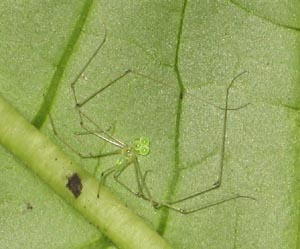 After the collecting trip to
the Dominican Republic in 2005, I
visited Haiti in November/December
2007 in order to complete my studies of Hispaniolan pholcids. Even
though the country is ecologicaly in a mostly impoverished or even
dismal condition, some patches of primary or fairly well
preserved secondary forest are still present, mostly in remote areas.
The poor conditions of the roads mean that these remnants are
difficult to reach, even with 4-wheel drive. Our first stop was at the
La Visite National Park south of Port-au-Prince, where I collected in
several places, including a
small patch of remaning broadleaf forest, locally known as "Berac".
After the collecting trip to
the Dominican Republic in 2005, I
visited Haiti in November/December
2007 in order to complete my studies of Hispaniolan pholcids. Even
though the country is ecologicaly in a mostly impoverished or even
dismal condition, some patches of primary or fairly well
preserved secondary forest are still present, mostly in remote areas.
The poor conditions of the roads mean that these remnants are
difficult to reach, even with 4-wheel drive. Our first stop was at the
La Visite National Park south of Port-au-Prince, where I collected in
several places, including a
small patch of remaning broadleaf forest, locally known as "Berac". 

The second location was Macaya National Park in the far southwest of Haiti. Like in La Visite, most of the remaining forest in this park is Caribbean pine, but some of the small patches of broadleaf forest still present are considered imortant refuge areas for much of what remains of Haitian biodiversity.
 Further collecting stops were
in the Artibonite valley, in
the Labadie area near Cap Haitien in the north, and in the mountains
between Cap Haitien and Gonaive. Some areas like the Artibonite valley
are beautiful, but every square meter seems to be used by humans, and
small patches of a few trees above coffee, banana, papaya, yucca, etc.
are the closest to a forest as it gets. Spiders share this heavily
anthropized habitat with hens, pigs, goats, and cows.
Further collecting stops were
in the Artibonite valley, in
the Labadie area near Cap Haitien in the north, and in the mountains
between Cap Haitien and Gonaive. Some areas like the Artibonite valley
are beautiful, but every square meter seems to be used by humans, and
small patches of a few trees above coffee, banana, papaya, yucca, etc.
are the closest to a forest as it gets. Spiders share this heavily
anthropized habitat with hens, pigs, goats, and cows.One of the things that impressed me most about Haiti was the warmth and friendliness of its people. Since the country is no tourist destination, I had had little opportunity to inform myself about it before the trip. The mostly negative media coverage about Haiti, and other tidbits like the warning of the German federal ministry for foreign affairs regarding trips to Haiti, had generated a fairly negative image in my mind. While there may indeed not be much positive to say about economic and environmental aspects, the way people cope with the extreme difficulties, their self-esteem and culture, and maybe an increasing international awareness of the potentially impending disaster, inspire some hope for improvement.


From a scientific point of view, the trip was quite successful. Only part of the material has so far been published, in two publications: one on Tainonia (Huber & Astrin 2009), one on Modisimus (Huber et al. 2010).
Above are representatives of two of the three Hispaniolan pholcid genera, documenting two possible ways of flattening the body in an effort to become invisible on the underside of leaves. On the left a Micropholcus, bending its legs to the front and then outwards. On the right a Modisimus, bending its legs back and then outwards. Obviously, the cryptic lifestyle on the underside of leaves, together with the greenish coloration, has been acquired independently in both genera.
